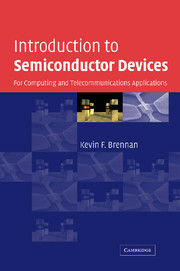Book contents
- Frontmatter
- Contents
- Preface
- List of physical constants
- List of materials parameters for important semiconductors, Si and GaAs
- 1 Semiconductor fundamentals
- 2 Carrier action
- 3 Junctions
- 4 Bipolar junction transistors
- 5 JFETs and MESFETs
- 6 Metal–insulator–semiconductor structures and MOSFETS
- 7 Short-channel effects and challenges to CMOS
- 8 Beyond CMOS
- 9 Telecommunications systems–an overview
- 10 Optoelectronic devices – emitters, light amplifiers, and detectors
- 11 Transistors for high frequency, high power amplifiers for wireless systems
- References
- Index
10 - Optoelectronic devices – emitters, light amplifiers, and detectors
Published online by Cambridge University Press: 05 June 2012
- Frontmatter
- Contents
- Preface
- List of physical constants
- List of materials parameters for important semiconductors, Si and GaAs
- 1 Semiconductor fundamentals
- 2 Carrier action
- 3 Junctions
- 4 Bipolar junction transistors
- 5 JFETs and MESFETs
- 6 Metal–insulator–semiconductor structures and MOSFETS
- 7 Short-channel effects and challenges to CMOS
- 8 Beyond CMOS
- 9 Telecommunications systems–an overview
- 10 Optoelectronic devices – emitters, light amplifiers, and detectors
- 11 Transistors for high frequency, high power amplifiers for wireless systems
- References
- Index
Summary
The primary optoelectronic devices of importance in lightwave communications systems are emitters, amplifiers, modulators, and detectors. Emitters are the front-end components of a lightwave communications system. The signal is input into the fiber using emitters. The most important emitters are light emitting diodes (LEDs) and lasers. As we will see, most communications systems use lasers due to their much higher power and relatively large modulation bandwidth as compared with LEDs. In addition to front-end emitters, modern lightwave communications systems utilize optical amplifiers for long distance communications. The natural attenuation of lightwave signals propagating through a fiber optic cable can be compensated by the use of amplifiers placed at periodic spatial intervals. In this way, very long distance fiber transmission lines can be made for transcontinental and transoceanic communications. The most attractive amplifiers in long distance lightwave networks are all optical devices since these structures are less costly and typically less noisy than their optoelectronic alternatives. In this chapter, we discuss the two most important semiconductor emitters, LEDs and lasers. The operating principles of these devices as well as various device types will be presented. Since the basic physics utilized in lasers, i.e., stimulated emission, is common to optical amplifiers, the chapter includes a discussion of the two most important optical amplifiers used in lightwave communications systems. These are EDFAs and SOAs. Finally, the chapter concludes with a discussion of photodetectors.
LEDs
The LED has become one of the most ubiquitous compound semiconductor devices. It is commonly employed in numerous applications including clocks, appliances, calculators, lighting, and signs. LEDs make up the largest share of commercial optical semiconductor products.
- Type
- Chapter
- Information
- Introduction to Semiconductor DevicesFor Computing and Telecommunications Applications, pp. 230 - 274Publisher: Cambridge University PressPrint publication year: 2005



